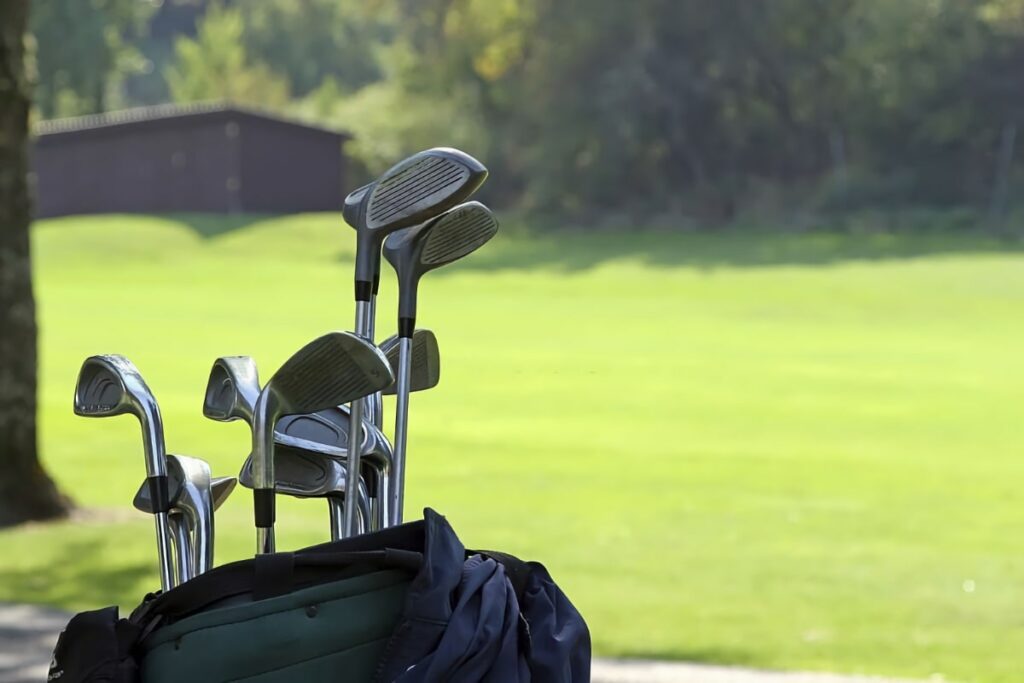For many of us golfers, our clubs are a prized possession — not least our putters.
Both the USGA and the R&A enforce the rule that golfers can carry up to 14 clubs in their golf bags. But does the putter count in the 14 clubs?
In this article, you’ll learn whether the putter is included in the club allocation. Also, I’ll share the most common set of clubs carried in the average 14-club golf bag.
Ready? Let’s dive straight into it.
Does the Putter Count in the 14 Clubs?
Yes, the putter does count in the 14 clubs. Rule 4.1b, set by the USGA and the R&A, permits you to carry up to 14 clubs in a round of golf. But, there are no restrictions on the type of clubs you carry, provided that they conform to the rules.
The putter is a very low-lofted club, with the sole task of knocking the ball into the hole.
Yet, while the putter looks visually different from the other clubs in the bag, it’s just as much a golf club as the rest in the bag. Hence, it’s included in the 14-club allocation.
So, what is the importance of the 14 club rule? Read on to learn more!

What Is the 14 Club Rule in Golf?
In golf, the 14 club rule limits players to no more than 14 clubs in the bag.
“You must not start a round with more than 14 clubs or have more than 14 clubs during the round… If you start a round with fewer than 14 clubs, you may add clubs during the round up to the 14-club limit.”
USGA Rule 4.1b — Limit of 14 clubs
So, why are we limited to 14 clubs? Essentially, the USGA created the rule on the principle that golf is a challenging game in which success should depend on your “judgment, skills, and abilities” — rather than the number of clubs you can carry.
Until the rule was enforced, golfers could carry as many clubs as they desired. But, this created a divide between those that could afford plenty of clubs to fit a variety of shots and those that could not. Side note — think of the poor caddies!
In 1938, the USGA and R&A governing bodies introduced the club restriction. 14 clubs were chosen as the number corresponded to the typical set carried by most players.
Nevertheless, the rule only limits the total number of clubs you are permitted to carry in the bag, not the clubs you choose to carry. For instance, you can opt to carry 2 putters in your golf bag if you wish — as Adam Scott did in the 2018 PGA Championship.
Ultimately, 14 clubs are more than enough to navigate the golf course — provided that you choose the right set of clubs with sufficient distance gapping.
In the next section of this article, you’ll learn about the concept of gapping, and how it should inform the club selection process for the average golfer.

What Clubs Should the Average Golfer Carry?
The average golfer carries 3-4 woods, 5-6 irons, 3-4 wedges, and a putter. However, many golfers won’t use their full 14-club allocation, keeping the bag lightweight.
When deciding which clubs to carry, it’s vital to understand gapping.
Essentially, gapping is the number between the distance you hit each of your clubs.
On average, 1 degree of loft equals around 2 to 4 yards of distance. Broadly speaking, the yardage gap between clubs should be between 10 and 15 yards.
Therefore, you should aim for approximately 4 degrees of loft between each club in the bag, which ensures you always have the correct club to use from any distance.
The Common 14 Clubs
While many carry fewer, here are the most common 14 clubs in the average golf bag:
| Club | Avg. Loft (Degrees) | Avg. Distance (Yards) |
| Driver | 11 | 230 |
| 3 Wood | 15 | 215 |
| 3 Hybrid | 20 | 190 |
| 4 Iron | 24 | 170 |
| 5 Iron | 27 | 160 |
| 6 Iron | 30 | 150 |
| 7 Iron | 34 | 140 |
| 8 Iron | 38 | 130 |
| 9 Iron | 42 | 120 |
| P Wedge | 46 | 105 |
| G Wedge | 52 | 90 |
| S Wedge | 56 | 80 |
| L Wedge | 60 | 70 |
| Putter | 4 | n/a |
As you can see, gapping is never perfect. Unless you’re a tour pro, there’s no need to worry about having precise 10-15 yard gaps between each club.
Instead, you should focus on avoiding any glaringly obvious distance gaps.
For instance, if you removed the pitching wedge from the bag, there would be a large gap between the gap wedge and the 9 iron. This is particularly important to avoid in the shorter clubs, as you will hit many approach shots within this distance range.
Of course, there’s lots of flexibility in the clubs you might choose to carry. In some cases, golfers who play long courses might choose to carry an extra wood (like a 5 wood) rather than four wedges. This will give you more options for longer shots.
In essence, you should assemble the clubs in your bag based on your strengths as a golfer, as well as the type of courses you play most frequently.

What Clubs Should a Senior Golfer Carry?
Senior golfers often choose to carry more hybrids and fairway woods than the average golfer. Hybrids and woods have larger club heads, making it easier to launch the ball higher and longer at lower swing speeds than standard irons.
Many senior golfers have found hybrids to be their favorite clubs in the bag. They offer the benefits of woods and irons in one club — providing a large and forgiving club head that can generate better launch and distance with a relatively slow swing speed.
They are also incredibly easy to hit. With a wider sole and a larger sweet spot, you’ll find that hybrids are easier to strike consistently well — out of the fairway or thick rough.
So, rather than carrying a set of six irons (typically from 4 iron to 9 iron), senior golfers are better off choosing six (or fewer) hybrids of similar lofts.
In addition, senior golfers should consider using a more flexible shaft in their clubs. This helps to compensate for the lack of swing speed, improving launch and distance.

Conclusion
In summary, the putter does count in the 14 clubs. While it looks different from the other clubs in the golf bag, it’s just as much a club as the rest of them!
In the 14-club allocation, the average golfer will carry 3-4 woods, 5-6 irons, 3-4 wedges, and a putter. Although, many players will carry fewer than 14 clubs to make the bag less heavy and simplify decision-making.
On the other hand, senior golfers might opt for more hybrids rather than irons. Hybrids are easier to hit at lower swing speeds, making the game far more enjoyable.


